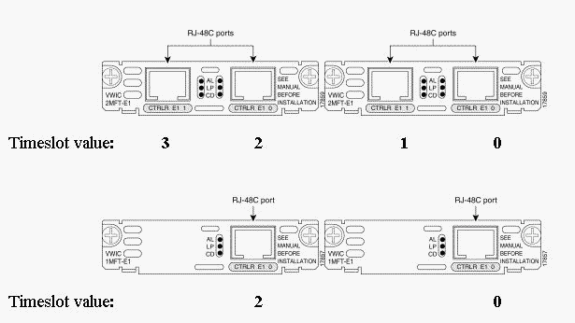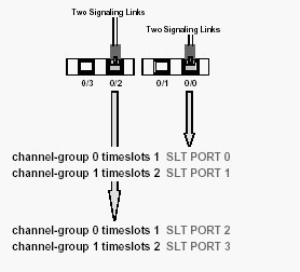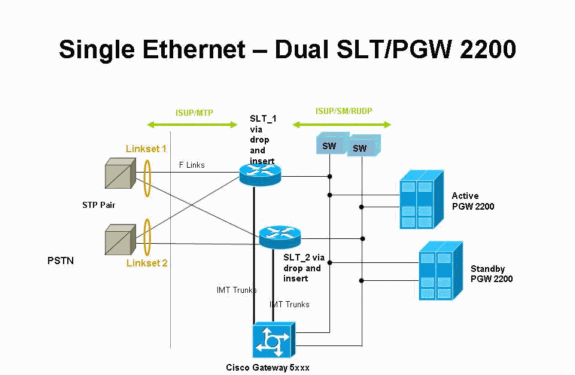PGW 2200 Softswitch: SLT 26xx Configuration
Available Languages
Download Options
Bias-Free Language
The documentation set for this product strives to use bias-free language. For the purposes of this documentation set, bias-free is defined as language that does not imply discrimination based on age, disability, gender, racial identity, ethnic identity, sexual orientation, socioeconomic status, and intersectionality. Exceptions may be present in the documentation due to language that is hardcoded in the user interfaces of the product software, language used based on RFP documentation, or language that is used by a referenced third-party product. Learn more about how Cisco is using Inclusive Language.
Contents
Introduction
This document provides a sample configuration designed to help with the installation of a Cisco 26xx Signaling Link Terminal (SLT) into the Cisco PGW 2200 configuration network.
Prerequisites
Requirements
Readers of this document should have knowledge of these topics:
- Cisco Media Gateway Controller - Software Release 9
- Cisco Signaling Link Terminal
- Cisco Feature Navigator II
- Troubleshooting Cisco SLT Signaling
- Cisco Signaling Link Terminal G.732 Support
- Cisco Signaling Link Terminal Dual Ethernet
- Multiple Origination Point Code Support for the Cisco Signaling Link Terminal
Components Used
The information in this document is based on these software versions:
-
Cisco PGW 2200 Software Releases 9.3(2) and 9.4(1)
The information in this document was created from the devices in a specific lab environment. All of the devices used in this document started with a cleared (default) configuration. If your network is live, make sure that you understand the potential impact of any command.
Conventions
Refer to the Cisco Technical Tips Conventions for more information on document conventions.
Configuration for the SLT 2611 and SLT 2651 with the PGW2200
In this section, you are presented with the information to configure the features described in this document.
Note: To find additional information on the commands used in this document, use the Command Lookup Tool (registered customers only) .
Network Diagrams
This document uses Single Ethernet/Dual SLT sessions. These network setups are provided in this section:
Most configuration errors start in the MML commands of the C7IPLNK configuration. This section provides a detailed look at provisioning the SS7 signaling link from Cisco PGW 2200 to the Cisco SLT:
prov-add:C7IPLNK:NAME="stp1-L1",DESC="C7link1 to STP1",LNKSET="lnkset-stp1",SLC=0,PRI=1, TIMESLOT=0,SESSIONSET="sess-slt1“
The label “timeslot” may be confusing in this context. This is not intended to represent a particular DS0 on a T1 or E1 interface card, but rather the slot on the Cisco SLT that the signaling link is physically plugged into.
This graphic represents the back of the Cisco SLT 26xx.

Note: If you install only one Voice and WAN Interface Card (VWIC), always install it in slot 0.
There are two WAN Interface card (WIC) slots, which can accept the modules discussed in this document. These modules are either single- or dual-port high speed serial or T1/E1 RJ48 interfaces. To determine which timeslot value to use in the C7IPLNK configuration, count the ports from right (closest to power supply) to left, from 0 to 3. For example, if part number WIC-2T is installed in the right-most WIC slot, timeslot 0 corresponds to the bottom serial interface (serial 0) and timeslot 1 would be the top interface (serial 1). If an additional interface card is installed in the left WIC slot, this numbering would continue as timeslot 2 and timeslot 3. The same holds true for all interface cards, though it becomes more complex when the Cisco SLT is configured with two single-port T1 or E1 VWIC’s. With this type of hardware configuration, the only valid timeslot values are 0 (for the port in the right VWIC) and 2 (for the port in the left VWIC). Though there is no physical port in this case, treat the “missing” port as a timeslot when counting right to left.
For further clarification, see these examples:

Note: You must define channel-group 0 before channel-group 1, and you must remove (no) channel-group 1 before channel-group 0. The only allowable values for channel-groups are 0 and 1.

Note: A Cisco 2611 SLT can only support two signaling links.
The Primary Rate Interface (PRI) parameter in the C7IPLNK configuration's MML command syntax:
prov-add:C7IPLNK:NAME="stp1-L1",DESC="C7link1 to STP1",LNKSET="lnkset-stp1",SLC=0, PRI=1,TIMESLOT=0,SESSIONSET="sess-slt1“
The highest priority setting is "1". If you have multiple links with the same priority setting, load-sharing between links occurs. If all of the links in a linkset are of the same speed, capacity and otherwise identical, then load-sharing is normally preferred. However, at least one link needs to have a priority setting of "1" if the other links are different in priority value.
The Signaling Link Code (SLC) parameter:
prov-add:C7IPLNK:NAME="stp1-L1",DESC="C7link1 to STP1",LNKSET="lnkset-stp1", SLC=0,PRI=1,TIMESLOT=0,SESSIONSET="sess-slt1“
The SLC parameter uniquely identifies the link. A linkset can contain up to 16 links; each link in the linkset has an identifier (a numerical value between 0 and 15). It is this value that is referred to as the SLC. Here you are to choose 0, as is normal practice for the first link in a linkset.
See these example sessions:
Fig 1: Cisco SLT / Cisco PGW 2200 Concept

Fig 2: Topology Concept with the IP Address

Configurations
This document uses these configurations:
A sample PGW 2200 configuration is show here:
Note: The italicized and bolded information in this document is for verification purposes, in case you run into any Cisco SLT configuration issues. You should have a good understanding of the items in bold during the time of the installation. Value changes may result in the SLT and PGW 2200 going out-of-service.
Note: Also, this document does not include complete configurations for access link or fully associated links, but does have some information regarding these links. The PGW 2200 Configuration only covers the Cisco SLT issues discussed, and points you to items that need attention.
| Cisco PGW 2200 Configuration |
|---|
mgc-bru-1 mml> prov-sta::srcver="active",dstver="cisco1" MGC-01 - Media Gateway Controller 2004-07-25 15:54:21.576 WEST M COMPLD "PROV-STA" ; mgc-bru-1 mml> prov-add:OPC:NAME="opc-PGW 2200",DESC="OPC for PGW",NETADDR="1.1.1",NETIND=2,TYPE="TRUEOPC" MGC-01 - Media Gateway Controller 2004-07-25 15:54:42.039 WEST M COMPLD "OPC" ; mgc-bru-1 mml> prov-add:DPC:NAME="na-ssp-pstn",DESC="Point Code for PSTN",NETADDR="1.1.3",NETIND=2 MGC-01 - Media Gateway Controller 2004-07-25 15:54:58.711 WEST M COMPLD "DPC" ; mgc-bru-1 mml> prov-add:APC:NAME="stp-1",DESC="APC ",NETADDR="1.1.6",NETIND=2 MGC-01 - Media Gateway Controller 2004-07-25 15:54:59.142 WEST M COMPLD "APC" ; mgc-bru-1 mml> prov-add:APC:NAME="stp-2",DESC="APC ",NETADDR="1.1.7",NETIND=2 MGC-01 - Media Gateway Controller 2004-07-25 15:54:59.544 WEST M COMPLD "APC" ; mgc-bru-1 mml> prov-add:EXTNODE:NAME="slt-1",DESC="c7ip-stp1 SLT",TYPE="SLT" MGC-01 - Media Gateway Controller 2004-07-25 15:55:00.064 WEST M COMPLD "EXTNODE" ; mgc-bru-1 mml> prov-add:EXTNODE:NAME="slt-2",DESC="c7ip-stp2 SLT",TYPE="SLT" MGC-01 - Media Gateway Controller 2004-07-25 15:55:02.494 WEST M COMPLD "EXTNODE" ; mgc-bru-1 mml> prov-add:SESSIONSET:NAME="sess-slt1",EXTNODE="slt-1",IPADDR1="IP_Addr1", PEERADDR1="10.15.2.3",PORT=7000,PEERPORT=7000,TYPE="BSMV0" MGC-01 - Media Gateway Controller 2004-07-25 15:58:29.203 WEST M COMPLD "SESSIONSET" ; mgc-bru-1 mml> prov-add:SESSIONSET:NAME="sess-slt2",EXTNODE="slt-2",IPADDR1="IP_Addr2", PEERADDR1="10.15.3.3",PORT=7000,PEERPORT=7000,TYPE="BSMV0" MGC-01 - Media Gateway Controller 2004-07-25 15:58:57.879 WEST M COMPLD "SESSIONSET" ; mgc-bru-1 mml> prov-add:LNKSET:NAME="lnkset-stp1",DESC="Linkset 1",APC="stp-1",PROTO="SS7-ANSI",TYPE="IP" MGC-01 - Media Gateway Controller 2004-07-25 15:58:58.526 WEST M COMPLD "LNKSET" ; mgc-bru-1 mml> prov-add:LNKSET:NAME="lnkset-stp2",DESC="Linkset 2 ",APC="stp-2",PROTO="SS7-ANSI",TYPE="IP" MGC-01 - Media Gateway Controller 2004-07-25 15:58:59.338 WEST M COMPLD "LNKSET" ; mgc-bru-1 mml> prov-add:SS7ROUTE:name="ss7-route1",desc="SS7Route",OPC="opc-PGW 2200",LNKSET="lnkset-stp1", PRI=1,dpc="stp-1" MGC-01 - Media Gateway Controller 2004-07-25 16:10:23.705 WEST M COMPLD "SS7ROUTE" ; mgc-bru-1 mml> prov-add:SS7ROUTE:name="ss7-route2",desc="SS7Route",OPC="opc-PGW 2200",LNKSET="lnkset-stp2", PRI=1,dpc="stp-2" MGC-01 - Media Gateway Controller 2004-07-25 16:11:33.559 WEST M COMPLD "SS7ROUTE" ; mgc-bru-1 mml> prov-add:C7IPLNK:NAME="stp1-L2",DESC="C7link2 to STP1",LNKSET="lnkset-stp1",SLC=1,PRI=1, TIMESLOT=0,SESSIONSET="sess-slt2" MGC-01 - Media Gateway Controller 2004-07-25 16:12:44.549 WEST M COMPLD "C7IPLNK" ; mgc-bru-1 mml> prov-add:C7IPLNK:NAME="stp1-L1",DESC="C7link1 to STP1",LNKSET="lnkset-stp1",SLC=0,PRI=1, TIMESLOT=0,SESSIONSET="sess-slt1" MGC-01 - Media Gateway Controller 2004-07-25 16:12:32.141 WEST M COMPLD "C7IPLNK" ; mgc-bru-1 mml> prov-add:C7IPLNK:NAME="stp2-L1",DESC="C7link1 to STP2",LNKSET="lnkset-stp2",SLC=0,PRI=1, TIMESLOT=1,SESSIONSET="sess-slt1" MGC-01 - Media Gateway Controller 2004-07-25 16:12:33.494 WEST M COMPLD "C7IPLNK" ; mgc-bru-1 mml> prov-add:C7IPLNK:NAME="stp2-L2",DESC="C7link2 to STP2",LNKSET="lnkset-stp2",SLC=1,PRI=1, TIMESLOT=1,SESSIONSET="sess-slt2"" MGC-01 - Media Gateway Controller 2004-07-25 16:12:36.140 WEST M COMPLD "C7IPLNK" ; mgc-bru-1 mml> |
A sample Cisco SLT configuration is shown here:
Note: This design concept includes information from Fig 2: Topology Concept with the IP Address. The most important commands are bolded.
| Cisco SLT Configuration |
|---|
Building configuration... Current configuration : 2423 bytes ! ! Last configuration change at 10:25:22 WET Mon Mar 1 2004 ! service timestamps debug datetime msec service timestamps log datetime no service password-encryption ! hostname slt_1 ! memory-size iomem 40 clock timezone WET 1 clock summer-time WEST recurring last Sun Mar 1:00 last Sun Oct 1:00 ip subnet-zero no ip source-route ip cef load-sharing algorithm original ! ! no ip bootp server ! controller E1 0/0 framing NO-CRC4 channel-group 0 timeslots 16 ! controller E1 0/1 framing NO-CRC4 channel-group 0 timeslots 16 ! ! ! interface Ethernet0/0 ip address 10.15.2.3 255.255.255.0 no ip mroute-cache no cdp enable ! interface Serial0/0:0 no ip address ! interface Serial0/1:0 no ip address ! ip default-gateway 10.15.2.100 ip classless ip route 0.0.0.0 0.0.0.0 10.15.2.100 ! ss7 session 0 address 10.15.2.1 7000 10.15.2.3 7000 ss7 session 1 address 10.15.2.2 7000 10.15.2.3 7000 ss7 mtp2-variant itu 0 SUERM-number-octets 16 ss7 mtp2-variant itu 1 SUERM-number-octets 16 ss7 mtp2-variant itu 2 SUERM-number-octets 16 ss7 mtp2-variant itu 3 SUERM-number-octets 16 end |
Verify
This section provides information you can use to confirm your configuration is working properly.
Certain show commands are supported by the Output Interpreter Tool (registered customers only) , which allows you to view an analysis of show command output.
Check the Alarms on the Cisco PGW 2200
Use these steps in order to test the Cisco PGW 2200 alarms:
-
Verify these alarms are generated by shutting down the Ethernet 0/0 connection on the Cisco SLT:
-
This is the alarm generated on the Cisco PGW 2200 when Ethernet 0/0 is shutdown:
MGC - Media Gateway Controller 2004-07-22 10:42:41.695 ** ":ALM=\"IP CONNECTION FAILED\",STATE=SET" ;
-
This is the alarm generated on the Cisco PGW 2200 when Ethernet 0/0 is restored:
MGC - Media Gateway Controller 2004-07-22 10:45:32.308 ":ALM=\"IP CONNECTION FAILED\",STATE=CLEARED" ;
-
-
Verify these alarms are generated by unplugging the Ethernet 0/0 connection:
The alarm generated on the Cisco PGW 2200 when the connection is unplugged:
MGC - Media Gateway Controller 2004-07-22 14:19:43.220 ** ":ALM=\"LIF FAIL\",STATE=SET" ; MGC - Media Gateway Controller 2004-07-22 14:19:43.221 ** ":ALM=\"LIF FAIL\",STATE=SET" ;; MGC - Media Gateway Controller 2004-07-22 14:19:50.329 ** ":ALM=\"IP CONNECTION FAILED\",STATE=SET" ; MGC - Media Gateway Controller 2004-07-22 14:19:50.330 ** ":ALM=\"IP CONNECTION FAILED\",STATE=SET" ; Alarm generated on the Cisco PGW 2200 when connection is restored: MGC - Media Gateway Controller 2004-07-22 14:22:20.781 ":ALM=\"LIF FAIL\",STATE=CLEARED" ; MGC - Media Gateway Controller 2004-07-22 14:22:20.784 ":ALM=\"LIF FAIL\",STATE=CLEARED" ; MGC - Media Gateway Controller 2004-07-22 14:22:51.036 ":ALM=\"IP CONNECTION FAILED\",STATE=CLEARED" ; MGC - Media Gateway Controller 2004-07-22 14:22:51.036 ":ALM=\"IP CONNECTION FAILED\",STATE=CLEARED" ;Note: The Cisco PGW 2200 sets the spare to 11, and some SS7 switches require a value of "00".
You can change the mtp3MsgPriority property value to "1" on the Cisco PGW 2200, as shown here:
prov-ed:sigsvcprop:name="ss7 path name",SS7-ITU.mtp3MsgPriority="1"
You can issue the Cisco PGW 2200 MML help command to find out details about the SS7 signaling variants which are supported for this change. This adds the capability to overwrite the default values of the linkset properties.
The syntax of the MML help command is given here:
Note: In the output shown here, prov-ed:lnksetprop:name="<prot fam>",<prop name>="<prop val>".
mgc-bru-1 mml> help :prov-ed:lnksetprop: MGC-01 - Media Gateway Controller 2004-09-09 16:46:49.147 WEST M RTRV prov-ed:lnksetprop ------------------------------------------------------------- Purpose: -------- Edits a component in the MGC configuration. Syntax: ------- prov-ed:<component/target>:name="<MML name>",<param name>=<param value>,... Input Description: ------------------ Target/Component -- lnksetprop -- Link Set Properties <Press 'SPACE' for next page, 'Enter' for next line or 'q' to quit this output> * name -- Link Set Name -- Choices in quotes: MGCP, EISUP, DPNSS, ISDNPRI, SS7-ANSI, SS7-ITU, SS7-UK, SS7-China, SS7-Japan * property -- Property Name -- Link Set Properties in quotes. ; torture mml> torture mml> rtrv-ne MGC-01 - Media Gateway Controller 2004-09-09 16:18:27.124 WEST M RTRV "Type:MGC" "Hardware platform:sun4u sparc SUNW,Ultra-30" "Vendor:"Cisco Systems, Inc."" "Location:MGC-01 - Media Gateway Controller" "Version:"9.4(1)"" "Platform State:ACTIVE" ; torture mml> prov-sta::srcver="active",dstver="klm123" MGC-01 - Media Gateway Controller 2004-09-09 16:18:55.741 WEST M COMPLD "PROV-STA" torture mml> torture mml> prov-ed:lnksetprop:name="SS7-ITU",mtp3MsgPriority="1" MGC-01 - Media Gateway Controller 2004-09-09 16:40:41.534 WEST M COMPLD "lnksetprop: WARNING: Restart is needed based on the property(s) added/modified. Refer to MGC Provisioning Guide." ; torture mml> prov-cpy MGC-01 - Media Gateway Controller 2004-09-09 16:41:11.857 WEST M COMPLD "PROV-CPY" ; torture mml>
-
Add the capability to retrieve the default values of signaling service properties. The syntax of the MML command used is given here:
prov-rtrv:sigsvcprop:name="<prot fam>"
Note: You need to stop and restart the Cisco PGW 2200 software after these changes.
Currently, all the MTP3 Management messages are set a priority of 3 (A/B bit in the Sub Service field of SIO set to 11).
Bitmask ID Name Comment or Value -1110101 Backward Sequence Number 117 1------- Backward Indicator Bit 1 1110111 Forward Sequence Number 119 1------- Forward Indicator Bit 1 --010000 Length Indicator 16 00------ Spare 0 ----0001 Service Indicator Sig. network test and maint. mess --11---- Sub-Service: Priority Priority 3 (U.S.A. only) 10------ Sub-Service: Network Ind. National message **b14*** Destination Point Code 01-011 **b14*** Originating Point Code 01-012 According to MTP3 philosophy, if a congestion hits a node, you could start to drop messages beginning with lower priority messages. MTP3 Management messages are very important as they signify the state of various elements on MTP3. If they are not kept of the highest priority (for example, a priority setting of 3 and A or B bits set to 11), there is a potential chance that during congestion scenarios, the switch starts to drop MTP3 Management messages. To ensure that MTP3 Management messages are the last dropped, ensure the msg. priority parameter is set to 11.
If you set the MTP3 Management A or B bits to 0, that would set the priority of the MTP3 Management messages to the minimum value (zero), which is usually not ideal. However, some SS7 switches prefer this scenario if configuration changes are made.
Remote C26xx SLT
These are recommendations for a remote Cisco C26xx SLT; they do not guarantee 100 percent call completion rates nor 100 percent SS7 link in-service time. Verify these conditions apply:
-
End-to-end delay (one way) is less than 150 ms.
-
Packet loss does not exceed one percent (preferably below a half percent).
-
For packet loss rates below a half percent, increase the Reliable User Datagram Protocol (RUDP) receive window sizes on the Cisco SLT to enhance the performance of the Cisco MGC.
RUDP Receive Window Adjustments
To change the RUDP receive window on the Cisco PGW 2200, from *.rudpWindowSz = 32 to *.rudpWindowSz = 64:
-
Execute these commands on the active PGW in MML:
-
prov-sta::srcver="active"
-
dstver="ciscotac-1" prov-ed:sessionprop:name="sess-slt1"
-
rudpWindowSz="64" prov-ed:sessionprop:name="sess-slt2"
-
rudpWindowSz="64" prov-dply
-
-
On the Cisco SLT, configure:
ss7 session 0 m_rcvnum 64 ss7 session 1 m_rcvnum 64 ss7 session 2 m_rcvnum 64 ss7 session 3 m_rcvnum 64
-
Collect this information after you have made the change from 32 to 64:
slt_1#show ss7 sm stats -------------------- Session Manager -------------------- Session Manager state = SESSION SET STATE-ACTIVE Session Manager Up count = 1 Session Manager Down count = 0 lost control packet count = 0 lost PDU count = 0 failover timer expire count = 0 invalid_connection_id_count = 0 Session[0] statistics SM SESSION STATE-ACTIVE: Session Down count = 0 Open Retry count = 0 Total Pkts receive count = 23812 Active Pkts receive count = 646 Standby Pkts receive count = 2 PDU Pkts receive count = 23163 Unknown Pkts receive count = 0 Pkts send count = 25689 Pkts requeue count = 6439 -Pkts window full count = 6439
Troubleshoot
There is currently no specific troubleshooting information available for this configuration.
 Feedback
Feedback